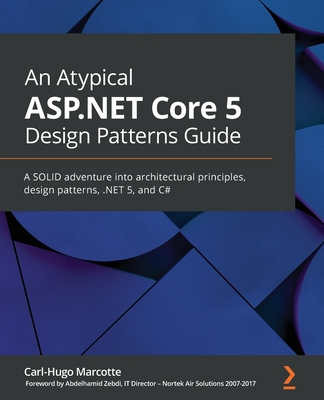Microservices Design Patterns in .NET: Making sense of microservices design and architecture using .NET Core (Paperback)
暫譯: .NET中的微服務設計模式:使用.NET Core理解微服務設計與架構 (平裝本)
Williams, Trevoir
- 出版商: Packt Publishing
- 出版日期: 2023-01-13
- 售價: $1,640
- 貴賓價: 9.5 折 $1,558
- 語言: 英文
- 頁數: 300
- 裝訂: Quality Paper - also called trade paper
- ISBN: 1804610305
- ISBN-13: 9781804610305
-
相關分類:
Microservices 微服務
立即出貨 (庫存=1)
買這商品的人也買了...
-
 Using SQLite (Paperback)
Using SQLite (Paperback)$2,110$2,005 -
 $700Professional Scrum Development with Microsoft Visual Studio 2012 (Paperback)
$700Professional Scrum Development with Microsoft Visual Studio 2012 (Paperback) -
 $796深度學習
$796深度學習 -
 演算法之美:隱藏在資料結構背後的原理 (C++版)
演算法之美:隱藏在資料結構背後的原理 (C++版)$650$507 -
 演算法圖鑑:26種演算法 + 7種資料結構,人工智慧、數據分析、邏輯思考的原理和應用 step by step 全圖解
演算法圖鑑:26種演算法 + 7種資料結構,人工智慧、數據分析、邏輯思考的原理和應用 step by step 全圖解$450$356 -
 JavaScript 資料結構及演算法實作 (暢銷回饋版)
JavaScript 資料結構及演算法實作 (暢銷回饋版)$300$234 -
 深入學習 JavaScript 模組化設計 (Mastering Modular JavaScript)
深入學習 JavaScript 模組化設計 (Mastering Modular JavaScript)$400$316 -
 $709微服務架構設計模式 (Microservices Patterns: With examples in Java)
$709微服務架構設計模式 (Microservices Patterns: With examples in Java) -
 手機攝影必學 BOOK:用OX帶你學會拍人物、食物、風景等情境照片
手機攝影必學 BOOK:用OX帶你學會拍人物、食物、風景等情境照片$398$299 -
 創意競擇:從賈伯斯黃金年代的軟體設計機密流程,窺見蘋果的創意方法、本質與卓越關鍵
創意競擇:從賈伯斯黃金年代的軟體設計機密流程,窺見蘋果的創意方法、本質與卓越關鍵$460$391 -
 Web 開發者一定要懂的駭客攻防術 (Web Security for Developers: Real Threats, Practical Defense)
Web 開發者一定要懂的駭客攻防術 (Web Security for Developers: Real Threats, Practical Defense)$420$332 -
 單體式系統到微服務 (Monolith to Microservices)
單體式系統到微服務 (Monolith to Microservices)$580$458 -
 資料科學的統計實務 : 探索資料本質、扎實解讀數據,才是機器學習成功建模的第一步
資料科學的統計實務 : 探索資料本質、扎實解讀數據,才是機器學習成功建模的第一步$599$539 -
 Martin Fowler 的企業級軟體架構模式:軟體重構教父傳授 51個模式,活用設計思考與架構決策 (Patterns of Enterprise Application Architecture)
Martin Fowler 的企業級軟體架構模式:軟體重構教父傳授 51個模式,活用設計思考與架構決策 (Patterns of Enterprise Application Architecture)$800$624 -
 我懂了!專案管理 (暢銷紀念版)
我懂了!專案管理 (暢銷紀念版)$400$316 -
 電腦視覺機器學習實務|建立端到端的影像機器學習 (Practical Machine Learning for Computer Vision: End-To-End Machine Learning for Images)
電腦視覺機器學習實務|建立端到端的影像機器學習 (Practical Machine Learning for Computer Vision: End-To-End Machine Learning for Images)$780$616 -
 建構微服務|設計細微化的系統, 2/e (Building Microservices: Designing Fine-Grained Systems, 2/e)
建構微服務|設計細微化的系統, 2/e (Building Microservices: Designing Fine-Grained Systems, 2/e)$880$695 -
 高並發系統實戰派:集群、Redis 緩存、海量存儲、Elasticsearch、RocketMQ、微服務、持續集成等
高並發系統實戰派:集群、Redis 緩存、海量存儲、Elasticsearch、RocketMQ、微服務、持續集成等$654$621 -
 $2,185Learning Blazor: Build Single-Page Apps with Webassembly and C# (Paperback)
$2,185Learning Blazor: Build Single-Page Apps with Webassembly and C# (Paperback) -
 ASP.NET Core Razor Pages in Action (Paperback)
ASP.NET Core Razor Pages in Action (Paperback)$2,160$2,052 -
 $607Azure、DevOps 和微服務軟件架構實戰, 2/e
$607Azure、DevOps 和微服務軟件架構實戰, 2/e -
 無瑕的程式碼 軟體工匠篇:程式設計師必須做到的紀律、標準與倫理 (Clean Craftsmanship: Disciplines, Standards, and Ethics)
無瑕的程式碼 軟體工匠篇:程式設計師必須做到的紀律、標準與倫理 (Clean Craftsmanship: Disciplines, Standards, and Ethics)$720$562 -
 從源頭就優化 - 動手開發自己的編譯器實戰
從源頭就優化 - 動手開發自己的編譯器實戰$880$695 -
 UX 商業價值實現之道|打造成功的數位產品服務 (UX for Business: How to Design Valuable Digital Companies)
UX 商業價值實現之道|打造成功的數位產品服務 (UX for Business: How to Design Valuable Digital Companies)$780$616 -
 建構可擴展系統|設計分散式架構 (Foundations of Scalable Systems: Designing Distributed Architectures)
建構可擴展系統|設計分散式架構 (Foundations of Scalable Systems: Designing Distributed Architectures)$780$616
相關主題
商品描述
Learn to be deliberate and intentional in your design, technology, and pattern choices when developing an application using a microservices architecture.
Key Features
- Tackle common design problems when developing a microservices application using .NET Core
- Explore applying S.O.L.I.D development principles in developing a stable microservice application
- Use your knowledge to solve common microservice application design challenges
Book Description
Are you a developer who needs to fully understand the different patterns and benefits that they bring to designing microservices? If yes, then this book is for you. Microservices Design Patterns in .NET will help you appreciate the various microservice design concerns and strategies that can be used to navigate them.
Making a microservice-based app is no easy feat and there are many concerns that need to be addressed. As you progress through the chapters of this guide, you'll dive headfirst into the problems that come packed with this architectural approach, and then explore the design patterns that address these problems. You'll also learn how to be deliberate and intentional in your architectural design to overcome major considerations in building microservices.
By the end of this book, you'll be able to apply critical thinking and clean coding principles when creating a microservices application using .NET Core.
What you will learn
- Use Domain-Driven Design principles in your microservice design
- Leverage patterns like event sourcing, database-per-service, and asynchronous communication
- Build resilient web services and mitigate failures and outages
- Ensure data consistency in distributed systems
- Leverage industry standard technology to design a robust distributed application
- Find out how to secure a microservices-designed application
- Use containers to handle lightweight microservice application deployment
Who this book is for
If you are a .NET developer, senior developer, software architect, or DevOps engineer who wants to explore the pros and cons, intricacies, and overall implementation of microservice architecture, then this book is for you. You'll also get plenty of useful insights if you're seeking to expand your knowledge of different design patterns and supporting technologies.
Basic experience with application and API development with .NET Core (2+) and C# will help you get the most out of this book.
商品描述(中文翻譯)
學習在使用微服務架構開發應用程式時,對設計、技術和模式選擇進行深思熟慮和有意識的選擇。
主要特點
- 解決使用 .NET Core 開發微服務應用程式時常見的設計問題
- 探索在開發穩定的微服務應用程式中應用 S.O.L.I.D 開發原則
- 利用您的知識解決常見的微服務應用程式設計挑戰
書籍描述
您是否是一位需要充分理解不同模式及其在設計微服務中所帶來的好處的開發者?如果是,那麼這本書適合您。《.NET 中的微服務設計模式》將幫助您理解各種微服務設計問題和可以用來應對這些問題的策略。
製作基於微服務的應用程式並非易事,並且有許多問題需要解決。在本指南的各章中,您將深入探討這種架構方法所帶來的問題,然後探索解決這些問題的設計模式。您還將學習如何在架構設計中進行深思熟慮和有意識的選擇,以克服構建微服務時的主要考量。
在本書結束時,您將能夠在使用 .NET Core 創建微服務應用程式時應用批判性思維和乾淨編碼原則。
您將學到的內容
- 在微服務設計中使用領域驅動設計原則
- 利用事件來源、每個服務的資料庫和非同步通信等模式
- 構建具有彈性的網路服務,減少故障和中斷
- 確保分散式系統中的資料一致性
- 利用行業標準技術設計穩健的分散式應用程式
- 瞭解如何保護微服務設計的應用程式
- 使用容器處理輕量級微服務應用程式的部署
本書適合誰
如果您是 .NET 開發者、高級開發者、軟體架構師或 DevOps 工程師,想要探索微服務架構的優缺點、複雜性和整體實施,那麼這本書適合您。如果您希望擴展對不同設計模式和支援技術的知識,您也會獲得許多有用的見解。
具備使用 .NET Core (2+) 和 C# 進行應用程式和 API 開發的基本經驗將幫助您充分利用本書。
目錄大綱
1. Introduction To Microservices: The Big Picture
2. Working with the Aggregator Pattern
3. Implementing the Chain of Responsibility Pattern (Synchronous Communication)
4. Asynchronous Communication between microservices
5. Working with the CQRS Pattern
6. Applying Event Sourcing Patterns
7. Handling Data for Each Microservice with Database Per Service Pattern
8. Implement transactions across microservices using the Saga pattern
9. Build a fault-tolerant and resilient system with the Circuit Breaker Pattern
10. Performing Health Checks of your services
11. Reviewing the implementation of API Gateway Pattern
12. API Security with Bearer Tokens
13. Microservice Container Hosting
14. Implementing Centralized Logging for Microservices
15. Wrapping it all up
目錄大綱(中文翻譯)
1. Introduction To Microservices: The Big Picture
2. Working with the Aggregator Pattern
3. Implementing the Chain of Responsibility Pattern (Synchronous Communication)
4. Asynchronous Communication between microservices
5. Working with the CQRS Pattern
6. Applying Event Sourcing Patterns
7. Handling Data for Each Microservice with Database Per Service Pattern
8. Implement transactions across microservices using the Saga pattern
9. Build a fault-tolerant and resilient system with the Circuit Breaker Pattern
10. Performing Health Checks of your services
11. Reviewing the implementation of API Gateway Pattern
12. API Security with Bearer Tokens
13. Microservice Container Hosting
14. Implementing Centralized Logging for Microservices
15. Wrapping it all up



















